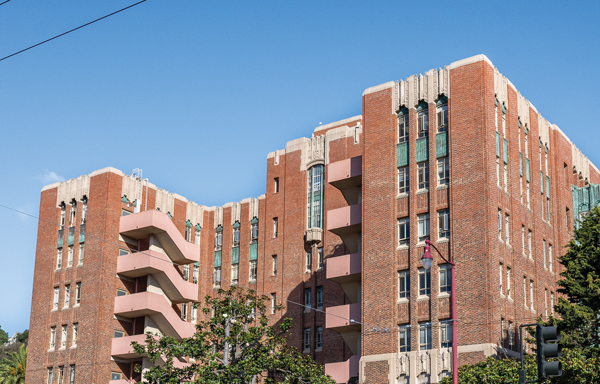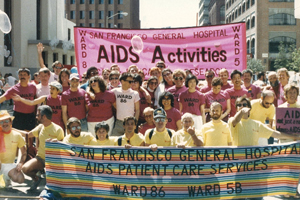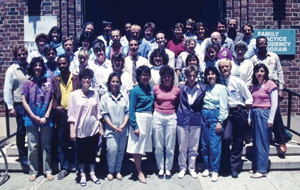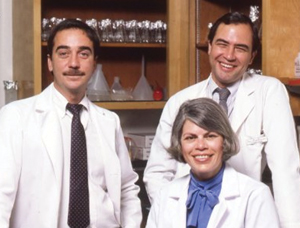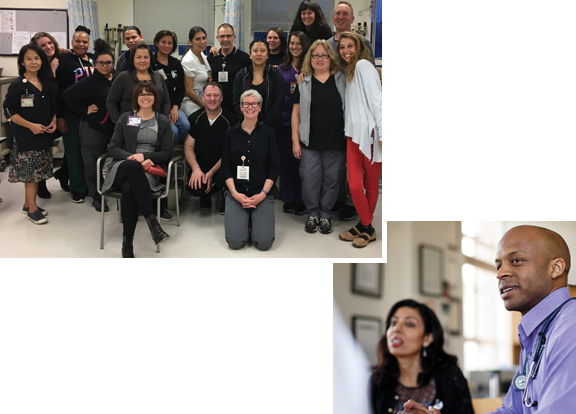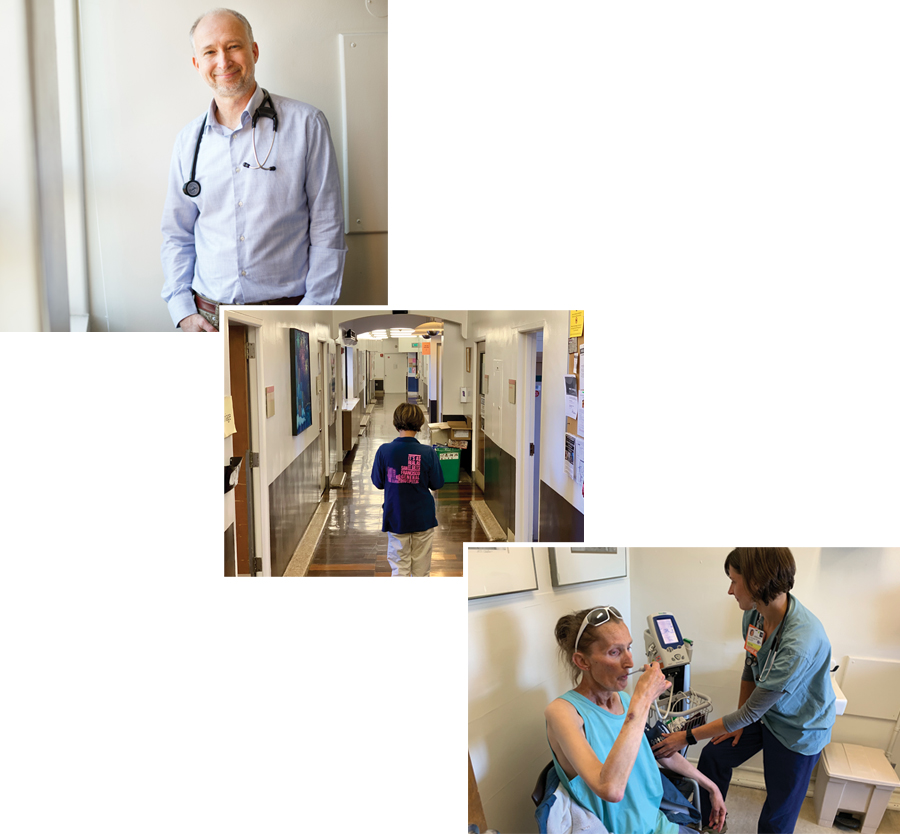Big ships turn slowly, according to the adage. The metaphor usually serves as an aphorism that warns against the slow nature of bureaucracy; whether it’s a university or the federal government, you can’t expect new ideas to take root or new policies to supplant old ones without a generation’s worth of debate, back and forth and compromise until the fateful day of implementation. That’s not the case with Ward 86.
‘It’s an exciting place to be because it’s so cutting edge’ —Monica Ghandi
The San Francisco-based HIV inpatient clinic, the first of its kind in the nation, which is celebrating its 40th anniversary this year, has made innovation with alacrity its hallmark, constantly pivoting to meet the changing needs and demands of the AIDS epidemic as it exists in the city outside its doors. “It’s an exciting place to be because it’s so cutting edge,” Monica Gandhi, MD, MPH, the current medical director, who has been in the role for a decade, said. “It doesn’t stop. It’s kind of exhausting, but it doesn’t stop.”
A recurring theme is that, as providers identify a need, they establish a program to address it. In 2008, they established a clinic for women with HIV. In 2013, they started a program to get people onto antiretroviral therapy the day they are diagnosed, something that, 10 years later, is now a standard of care in cities nationwide. When, in 2017, it became clear that the majority of people living with HIV in San Francisco were over the age of 50, it launched Golden Compass, a program to help address several of the complications that can accompany aging with HIV.
Another innovation came in 2019 with the opening of its POP-UP program, meant to address health care among people with unstable housing, who are much less likely to be virally suppressed than the average (and housed) San Franciscan living with the virus. In the past year, the program began administering long-acting antiretroviral medication to people who were previously detectable, including people who couldn’t adhere to daily ART because they experience homelessness, despite the treatment not being indicated for this particular group. They did this because they knew that the people seeing them for care needed it; because it was right. “It’s really exciting to be at a place like Ward 86, and to help lead it, because we aren’t treating an affluent population,” Monica Gandhi said. “We’re trying to benefit a patient population that in other fields sometimes gets advances last.”
One reason for such advances is Ward 86’s unique set of affiliations and partnerships: it is well-funded and enjoys support from the city’s Department of Public Health and is attached to a single academic institution, UCSF. The clinic’s success is not only a testament to those inside it, but to the good that can be done when innovation and public health are supported monetarily by those in power.
A sure sign of a landmark contribution to HIV care is when an entire treatment model is named after the city where it was born.
People who know the clinic’s reputation might wonder if it gets difficult to keep up a reputation of innovation, but their propensity to pioneer is not driven by a need to be first, it is driven completely by their person-centered approach. Because they keep close relationships with their clients, 96% of whom are on either Medicaid or Medicare, they are able to identify client needs and respond quickly with appropriate programs and initiatives. Gandhi has said that, in the past, she’s heard commentary saying the clinic is “so Wild West” in their approach, but she wears that as a badge of pride. “You have to be willing to take risks and think outside the box. It can backfire, but it’s worked out so far.”
A sure recognition of a landmark contribution is when an entire treatment model is named after the city where it was born. In the world of HIV care, the concept of a holistic approach to treating HIV is called the “San Francisco Model,” and it began at Ward 86, which early on recognized that treating HIV was about more than dispensing pills, but required a robust response from an entire care team. Today, this model has been deployed across the world, changing the way that people with HIV and care providers relate. Gandhi says part of her mission as the clinic’s medical director is to ensure that it disseminates, through channels such as conferences, journals, and community events, the successes they’ve encountered so that others can emulate it in a way that works for them.
Another essential ingredient to the clinic’s success is its unique relationship between patients and providers. These advances in treatment are the result of a staff that is attuned to the needs of the people who come through the clinic’s doors. For Steven Deeks, a professor of medicine at the University of California in San Francisco and a primary care provider at Ward 86 since 1993, it’s this deep symbiosis that has kept him working in the same place for three decades. He was supposed to stay there for only one year, but his interactions with patients, especially one named Joe, led him into activist communities such as Golden Gate ACT UP. He began to attend meetings and to know, intimately, the struggles of people living with HIV at the time. “I enjoyed the fierce advocacy and engagement,” he said. “I unexpectedly became more of an activist, as much an activist as a physician.”
That ability to know what patients want is what keeps them coming back, and even leads some people to seek out care there specifically, after years of living with HIV. Paul Aguilar, a long-term survivor who has been living with HIV since 1988, just came to Ward 86 last year because of its reputation. Aside from describing it as a “cutting edge place to get care for HIV,” Aguilar also emphasized that, when walking into the clinic, he automatically feels welcome. “Everyone knows my name. It’s like coming home.” Aguilar also credits the Golden Compass program for landing him with this care team. He says that few doctors are focused on treating the aging HIV population in a way that looks beyond CD4 count and viral load.
I have never once considered leaving Ward 86, I don’t think there’s any place like this in the world.
Being a part of this machine, a place that continues to care for people with HIV in ways that are old and new, continues to inspire Deeks. “I have never once considered leaving Ward 86,” he says. “I don’t think there’s any place like this in the world. That magic that occurred in the ’90s exists to this day. That same special sauce.” That special sauce is they key ingredient to its novel efforts. This past year, Ward 86 launched the Revival of Care program, which seeks to practice preventative care for potential complications, including cardiovascular disease, in people living with HIV.
As the clinic celebrates 40 years and looks ahead, Gandhi shared what she thought is the ward’s surprising future: obsolescence. “We are hoping in the next 40 years that we’re out of business because there is an HIV cure and an HIV vaccine,” she said. She acknowledges that, if—or when—such a breakthrough happens, Ward 86 wants to be poised to make it accessible to all, just as they have worked to make care available to anyone who needs it. In a way, her answer underlies just how willing to embrace the new the clinic really can be, that its dedication goes far beyond its name and its reputation. It’s all about the patients. Their job will be done when it comes to an end. “We don’t want to be here in 40 years. That’s our goal.”



